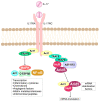The Role of IL-17 in the Pathogenesis of Oral Squamous Cell Carcinoma
- PMID: 37373022
- PMCID: PMC10298252
- DOI: 10.3390/ijms24129874
The Role of IL-17 in the Pathogenesis of Oral Squamous Cell Carcinoma
Abstract
Elucidating the inflammatory mechanisms underlying formation and progression of oral squamous cell carcinoma (OSCC) is crucial for discovering new targeted therapeutics. The proinflammatory cytokine IL-17 has proven roles in tumor formation, growth, and metastasis. The presence of IL-17 is demonstrated in both in vitro and in vivo models, and in OSCC patients, is mostly accompanied by enhanced proliferation and invasiveness of cancer cells. Here we review the known facts regarding the role of IL-17 in OSCC pathogenesis, namely the IL-17 mediated production of proinflammatory mediators that mobilize and activate myeloid cells with suppressive and proangiogenic activities and proliferative signals that directly induce proliferation of cancer cells and stem cells. The possibility of a potential IL-17 blockade in OSCC therapy is also discussed.
Keywords: inflammation; interleukin-17 (IL-17); oral squamous cell carcinoma (OSCC); therapeutic target; tumor progression.
Conflict of interest statement
The authors declare no conflict of interest.
Figures


References
-
- Nakashima T., Tomita H., Hirata A., Ishida K., Hisamatsu K., Hatano Y., Kanayama T., Niwa A., Noguchi K., Kato K., et al. Promotion of Cell Proliferation by the Proto-Oncogene DEK Enhances Oral Squamous Cell Carcinogenesis through Field Cancerization. Cancer Med. 2017;6:2424–2439. doi: 10.1002/cam4.1157. - DOI - PMC - PubMed
Publication types
MeSH terms
Substances
LinkOut - more resources
Full Text Sources
Medical

